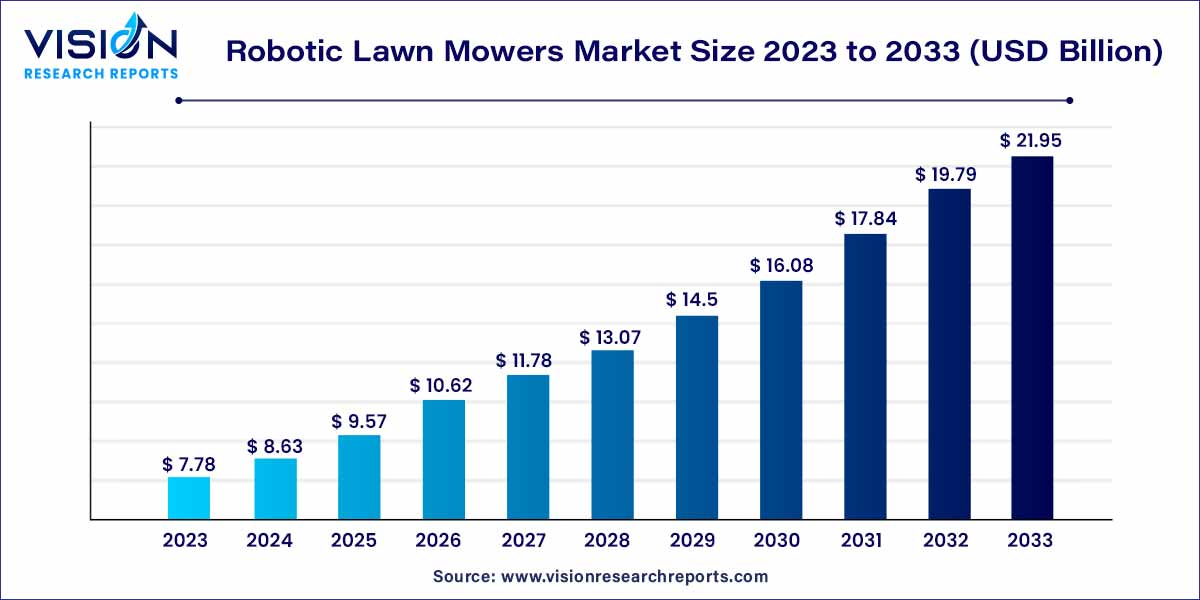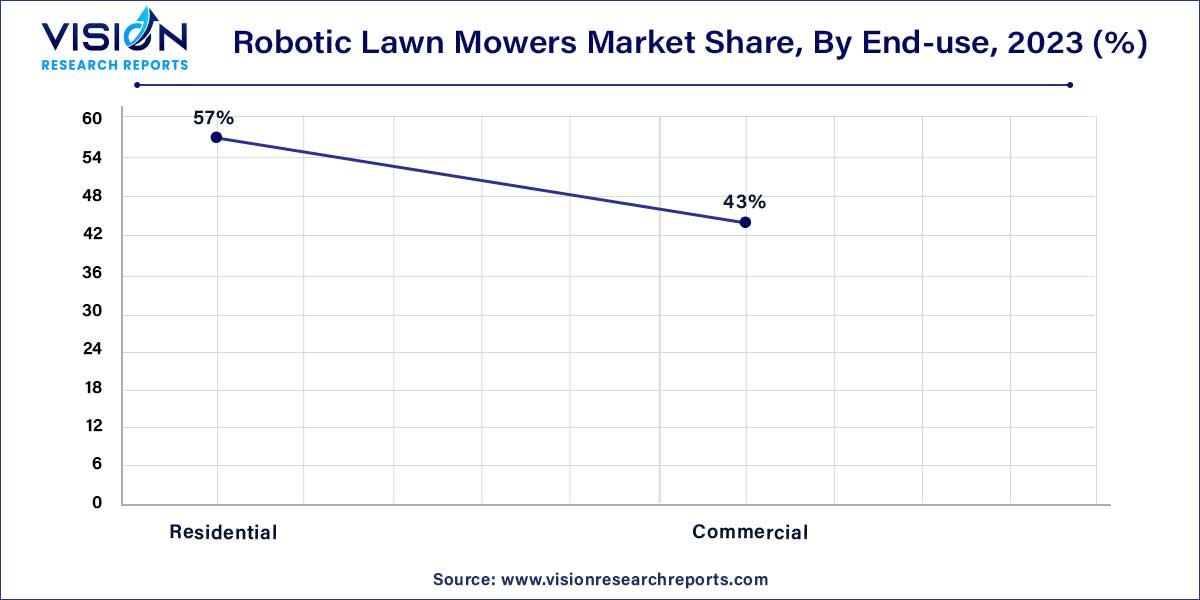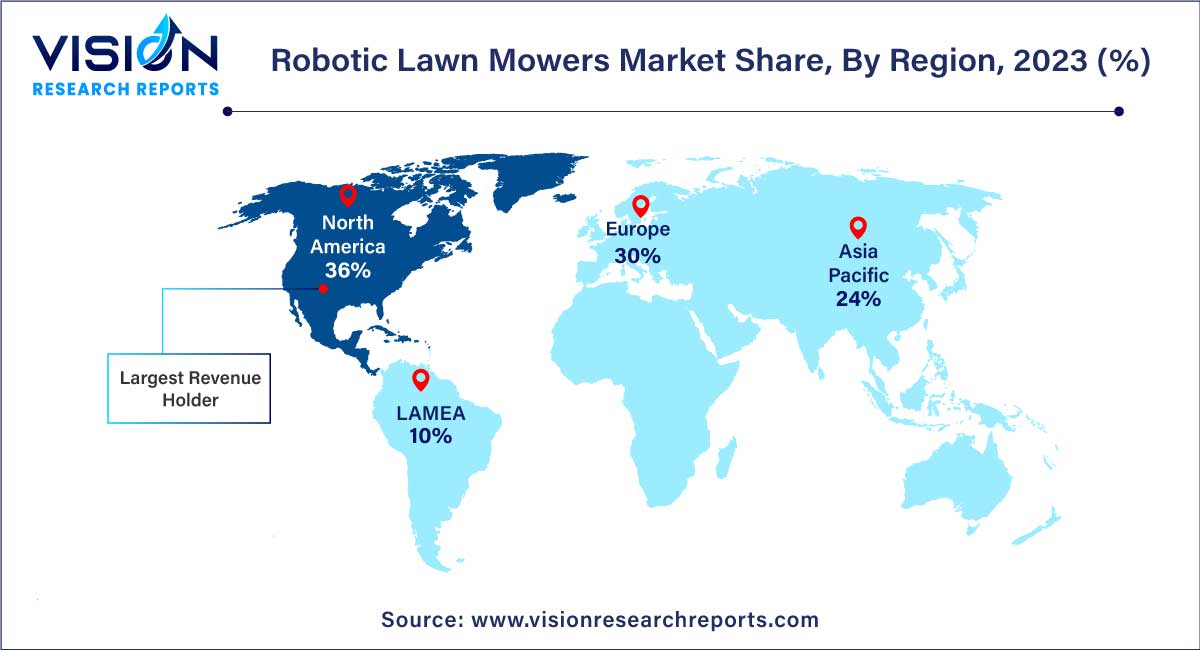The global robotic lawn mowers market was surpassed at USD 7.78 billion in 2023 and is expected to hit around USD 21.95 billion by 2033, growing at a CAGR of 10.93% from 2024 to 2033. The introduction of GPS-equipped, remote-controlled autonomous lawn mowers has simplified gardening by making these tools simple to track, monitor, and use. Furthermore, there has been a discernible surge in global consumer enthusiasm for gardening pursuits, leading to a heightened requirement for gardening implements like automated lawn mowers.

The robotic lawn mowers market has experienced substantial growth in recent years, fueled by technological advancements and a rising inclination towards smart and automated solutions for lawn maintenance. As a transformative force in the landscaping, robotic lawn mowers have garnered widespread attention for their efficiency, convenience, and ability to redefine traditional grass-cutting practices.
The growth of the robotic lawn mowers market is underpinned by several key factors. Firstly, continual technological advancements have played a pivotal role, with the integration of cutting-edge features such as advanced sensors, GPS navigation, and smart connectivity enhancing the overall performance and appeal of these devices. Secondly, the increasing demand for time-saving solutions in modern lifestyles has driven the adoption of robotic lawn mowers. The ability to operate autonomously with programmable schedules not only streamlines lawn maintenance but also allows homeowners to allocate their time more efficiently. Additionally, a growing emphasis on environmental sustainability has positioned robotic lawn mowers as eco-friendly alternatives, often operating on electric power and contributing to reduced emissions. While initial costs and perceived complexity may pose challenges, ongoing innovations and market competition are expected to address these concerns, fostering a positive outlook for sustained growth in the robotic lawn mowers market.
| Report Coverage | Details |
| Growth Rate from 2024 to 2033 | CAGR of 10.93% |
| Market Revenue by 2033 | USD 21.95 billion |
| Revenue Share of North America in 2023 | 36% |
| Base Year | 2023 |
| Forecast Period | 2024 to 2033 |
| Market Analysis (Terms Used) | Value (US$ Million/Billion) or (Volume/Units) |
Based on battery capacity, the 20V to 30V segment accounted for the largest revenue share of over 69% in 2023. Batteries in the 20V to 30V range predominantly feature in robotic lawn mowers used commercially. These relatively costlier products are often employed for mowing lawns that are 1.0 to 2.5 acres in size, often found in commercial areas such as sports/golf fields or the hospitality sector. The segment provides ample power to navigate various terrains, handle taller grass, and operate for extended periods between charges. Moreover, battery innovations have led to faster charging times and longer overall lifespans, addressing downtime and maintenance cost concerns. With app-based controls, GPS mapping, and automated scheduling, users can manage their lawn maintenance remotely effortlessly.
Up to 20V segment is anticipated to grow at a considerable growth rate over the forecast period. This is attributed to the rising usage of automated lawn mowers in residential applications. Up to 20V robotic lawn mowers are expected to become increasingly popular due to their eco-friendly and efficient operation. Up to 20V robotic lawn mowers offer extended operation times, covering larger areas on a single charge.
Based on sales channels, the retail stores/offline segment accounted for the largest revenue share of over 58% in 2023. The increasing demand for time-saving and convenient solutions has pushed traditional retail stores to embrace robotic lawn mowers. These devices cater to homeowners seeking effortless lawn maintenance, urge to a wide demographic ranging from busy professionals to elderly individuals who may find traditional mowing physically challenging. The sector's success is intrinsically tied to consumers' demands for convenience, variety, and value.
With the rise of e-commerce, consumers now expect seamless online and offline shopping experiences, pushing retailers to innovate and integrate digital technologies into their operations. Global economic conditions also significantly impact the retail sector. Economic factors such as GDP growth, inflation rates, and consumer confidence influence consumer spending patterns. During economic downturns, consumers often become more price-conscious and turn to discount retailers, while in times of prosperity, luxury and specialty stores tend to thrive. Moreover, geopolitical factors, trade policies, and supply chain disruptions can disrupt the flow of goods, affecting inventory management and pricing strategies.
The online segment is expected to register the highest growth over the forecast period. The growing trend of convenience-seeking consumers has propelled the demand for online shopping. With a few clicks, the customers can compare a wide range of robotic lawn mower models, features, and prices from their homes. One of the primary drivers is the widespread adoption of digital technologies and the increasing accessibility of the internet, which has connected billions of people worldwide. This connectivity has enabled consumers to shop conveniently from the comfort of their homes or mobile devices, thereby fuelling the demand for online shopping platforms. Another crucial factor propelling the e-commerce sector is the convenience and personalized shopping experiences offered by these platforms. Online retailers leverage sophisticated algorithms and data analytics to understand customer preferences, recommend products, and tailor marketing efforts, enhancing customer satisfaction and loyalty. In addition, the COVID-19 pandemic accelerated the shift towards online shopping as lockdowns and safety concerns prompted consumers to rely heavily on e-commerce for their everyday needs, further boosting the sector's growth.
Based on end-use, the residential sector segment held the largest revenue share of 57% in 2023. The increasing demand for convenience and time-saving solutions has led homeowners to seek automated alternatives for lawn maintenance. Robotic lawn mowers offer the advantage of hands-free operation, allowing homeowners to delegate the time-consuming task of mowing to a machine while they focus on other activities.

The commercial sector is expected to register considerable growth over the forecast period. Rising government investment into improving existing infrastructure, parks, and lawns near historic monuments is anticipated to drive the demand for robotic lawn mowers in the commercial sector. Also, the segment is also expected to witness significant growth over the forecast period owing to the steady growth of the hospitality and tourism industries.
North America dominated the market with a revenue share of over 36% in 2023. Busy lifestyle patterns resulted in end users' approach towards automating lawn maintenance activities. Robotic lawn mowers offer the convenience of hands-free operation, allowing users to allocate their time to more important activities. Innovations in sensors, artificial intelligence, and GPS navigation systems enable robotic lawn mowers to navigate and maintain lawns of varying sizes and complexities efficiently.

Asia Pacific region is expected to register the highest CAGR over the forecast period. In the Asia Pacific, the rapid urbanization and increasing affluence across countries have led to a rise in demand for smart and convenient home solutions. Robotic lawn mowers align with this trend by offering an automated and hassle-free way to maintain outdoor spaces, saving homeowners time and effort. Countries such as Japan, South Korea, and China have been at the forefront of robotics and automation, fostering a favourable environment for developing and deploying cutting-edge technologies.
By Battery Capacity
By Sales Channel
By End-use
By Region
Chapter 1. Introduction
1.1. Research Objective
1.2. Scope of the Study
1.3. Definition
Chapter 2. Research Methodology
2.1. Research Approach
2.2. Data Sources
2.3. Assumptions & Limitations
Chapter 3. Executive Summary
3.1. Market Snapshot
Chapter 4. Market Variables and Scope
4.1. Introduction
4.2. Market Classification and Scope
4.3. Industry Value Chain Analysis
4.3.1. Raw Material Procurement Analysis
4.3.2. Sales and Distribution Battery Capacity Analysis
4.3.3. Downstream Buyer Analysis
Chapter 5. COVID 19 Impact on Robotic Lawn Mowers Market
5.1. COVID-19 Landscape: Robotic Lawn Mowers Industry Impact
5.2. COVID 19 - Impact Assessment for the Industry
5.3. COVID 19 Impact: Global Major Government Policy
5.4. Market Trends and Opportunities in the COVID-19 Landscape
Chapter 6. Market Dynamics Analysis and Trends
6.1. Market Dynamics
6.1.1. Market Drivers
6.1.2. Market Restraints
6.1.3. Market Opportunities
6.2. Porter’s Five Forces Analysis
6.2.1. Bargaining power of suppliers
6.2.2. Bargaining power of buyers
6.2.3. Threat of substitute
6.2.4. Threat of new entrants
6.2.5. Degree of competition
Chapter 7. Competitive Landscape
7.1.1. Company Market Share/Positioning Analysis
7.1.2. Key Strategies Adopted by Players
7.1.3. Vendor Landscape
7.1.3.1. List of Suppliers
7.1.3.2. List of Buyers
Chapter 8. Global Robotic Lawn Mowers Market, By Battery Capacity
8.1. Robotic Lawn Mowers Market, by Battery Capacity, 2024-2033
8.1.1 Up to 20V
8.1.1.1. Market Revenue and Forecast (2021-2033)
8.1.2. 20V to 30V
8.1.2.1. Market Revenue and Forecast (2021-2033)
Chapter 9. Global Robotic Lawn Mowers Market, By Sales Channel
9.1. Robotic Lawn Mowers Market, by Sales Channel, 2024-2033
9.1.1. Retail Stores/Offline
9.1.1.1. Market Revenue and Forecast (2021-2033)
9.1.2. Online
9.1.2.1. Market Revenue and Forecast (2021-2033)
Chapter 10. Global Robotic Lawn Mowers Market, By End-use
10.1. Robotic Lawn Mowers Market, by End-use, 2024-2033
10.1.1. Residential
10.1.1.1. Market Revenue and Forecast (2021-2033)
10.1.2. Commercial
10.1.2.1. Market Revenue and Forecast (2021-2033)
Chapter 11. Global Robotic Lawn Mowers Market, Regional Estimates and Trend Forecast
11.1. North America
11.1.1. Market Revenue and Forecast, by Battery Capacity (2021-2033)
11.1.2. Market Revenue and Forecast, by Sales Channel (2021-2033)
11.1.3. Market Revenue and Forecast, by End-use (2021-2033)
11.1.4. U.S.
11.1.4.1. Market Revenue and Forecast, by Battery Capacity (2021-2033)
11.1.4.2. Market Revenue and Forecast, by Sales Channel (2021-2033)
11.1.4.3. Market Revenue and Forecast, by End-use (2021-2033)
11.1.5. Rest of North America
11.1.5.1. Market Revenue and Forecast, by Battery Capacity (2021-2033)
11.1.5.2. Market Revenue and Forecast, by Sales Channel (2021-2033)
11.1.5.3. Market Revenue and Forecast, by End-use (2021-2033)
11.2. Europe
11.2.1. Market Revenue and Forecast, by Battery Capacity (2021-2033)
11.2.2. Market Revenue and Forecast, by Sales Channel (2021-2033)
11.2.3. Market Revenue and Forecast, by End-use (2021-2033)
11.2.4. UK
11.2.4.1. Market Revenue and Forecast, by Battery Capacity (2021-2033)
11.2.4.2. Market Revenue and Forecast, by Sales Channel (2021-2033)
11.2.4.3. Market Revenue and Forecast, by End-use (2021-2033)
11.2.5. Germany
11.2.5.1. Market Revenue and Forecast, by Battery Capacity (2021-2033)
11.2.5.2. Market Revenue and Forecast, by Sales Channel (2021-2033)
11.2.5.3. Market Revenue and Forecast, by End-use (2021-2033)
11.2.6. France
11.2.6.1. Market Revenue and Forecast, by Battery Capacity (2021-2033)
11.2.6.2. Market Revenue and Forecast, by Sales Channel (2021-2033)
11.2.6.3. Market Revenue and Forecast, by End-use (2021-2033)
11.2.7. Rest of Europe
11.2.7.1. Market Revenue and Forecast, by Battery Capacity (2021-2033)
11.2.7.2. Market Revenue and Forecast, by Sales Channel (2021-2033)
11.2.7.3. Market Revenue and Forecast, by End-use (2021-2033)
11.3. APAC
11.3.1. Market Revenue and Forecast, by Battery Capacity (2021-2033)
11.3.2. Market Revenue and Forecast, by Sales Channel (2021-2033)
11.3.3. Market Revenue and Forecast, by End-use (2021-2033)
11.3.4. India
11.3.4.1. Market Revenue and Forecast, by Battery Capacity (2021-2033)
11.3.4.2. Market Revenue and Forecast, by Sales Channel (2021-2033)
11.3.4.3. Market Revenue and Forecast, by End-use (2021-2033)
11.3.5. China
11.3.5.1. Market Revenue and Forecast, by Battery Capacity (2021-2033)
11.3.5.2. Market Revenue and Forecast, by Sales Channel (2021-2033)
11.3.5.3. Market Revenue and Forecast, by End-use (2021-2033)
11.3.6. Japan
11.3.6.1. Market Revenue and Forecast, by Battery Capacity (2021-2033)
11.3.6.2. Market Revenue and Forecast, by Sales Channel (2021-2033)
11.3.6.3. Market Revenue and Forecast, by End-use (2021-2033)
11.3.7. Rest of APAC
11.3.7.1. Market Revenue and Forecast, by Battery Capacity (2021-2033)
11.3.7.2. Market Revenue and Forecast, by Sales Channel (2021-2033)
11.3.7.3. Market Revenue and Forecast, by End-use (2021-2033)
11.4. MEA
11.4.1. Market Revenue and Forecast, by Battery Capacity (2021-2033)
11.4.2. Market Revenue and Forecast, by Sales Channel (2021-2033)
11.4.3. Market Revenue and Forecast, by End-use (2021-2033)
11.4.4. GCC
11.4.4.1. Market Revenue and Forecast, by Battery Capacity (2021-2033)
11.4.4.2. Market Revenue and Forecast, by Sales Channel (2021-2033)
11.4.4.3. Market Revenue and Forecast, by End-use (2021-2033)
11.4.5. North Africa
11.4.5.1. Market Revenue and Forecast, by Battery Capacity (2021-2033)
11.4.5.2. Market Revenue and Forecast, by Sales Channel (2021-2033)
11.4.5.3. Market Revenue and Forecast, by End-use (2021-2033)
11.4.6. South Africa
11.4.6.1. Market Revenue and Forecast, by Battery Capacity (2021-2033)
11.4.6.2. Market Revenue and Forecast, by Sales Channel (2021-2033)
11.4.6.3. Market Revenue and Forecast, by End-use (2021-2033)
11.4.7. Rest of MEA
11.4.7.1. Market Revenue and Forecast, by Battery Capacity (2021-2033)
11.4.7.2. Market Revenue and Forecast, by Sales Channel (2021-2033)
11.4.7.3. Market Revenue and Forecast, by End-use (2021-2033)
11.5. Latin America
11.5.1. Market Revenue and Forecast, by Battery Capacity (2021-2033)
11.5.2. Market Revenue and Forecast, by Sales Channel (2021-2033)
11.5.3. Market Revenue and Forecast, by End-use (2021-2033)
11.5.4. Brazil
11.5.4.1. Market Revenue and Forecast, by Battery Capacity (2021-2033)
11.5.4.2. Market Revenue and Forecast, by Sales Channel (2021-2033)
11.5.4.3. Market Revenue and Forecast, by End-use (2021-2033)
11.5.5. Rest of LATAM
11.5.5.1. Market Revenue and Forecast, by Battery Capacity (2021-2033)
11.5.5.2. Market Revenue and Forecast, by Sales Channel (2021-2033)
11.5.5.3. Market Revenue and Forecast, by End-use (2021-2033)
Chapter 12. Company Profiles
12.1. AL-KO.
12.1.1. Company Overview
12.1.2. Product Offerings
12.1.3. Financial Performance
12.1.4. Recent Initiatives
12.2. Belrobotics.
12.2.1. Company Overview
12.2.2. Product Offerings
12.2.3. Financial Performance
12.2.4. Recent Initiatives
12.3. Deere & Company.
12.3.1. Company Overview
12.3.2. Product Offerings
12.3.3. Financial Performance
12.3.4. Recent Initiatives
12.4. Flymo.
12.4.1. Company Overview
12.4.2. Product Offerings
12.4.3. Financial Performance
12.4.4. Recent Initiatives
12.5. HONDA MOTOR CO., LTD.
12.5.1. Company Overview
12.5.2. Product Offerings
12.5.3. Financial Performance
12.5.4. Recent Initiatives
12.6. Husqvarna Group
12.6.1. Company Overview
12.6.2. Product Offerings
12.6.3. Financial Performance
12.6.4. Recent Initiatives
12.7. Robert Bosch GmbH.
12.7.1. Company Overview
12.7.2. Product Offerings
12.7.3. Financial Performance
12.7.4. Recent Initiatives
12.8. Robomow Friendly House
12.8.1. Company Overview
12.8.2. Product Offerings
12.8.3. Financial Performance
12.8.4. Recent Initiatives
12.9. STIGA S.p.A.
12.9.1. Company Overview
12.9.2. Product Offerings
12.9.3. Financial Performance
12.9.4. Recent Initiatives
12.10. WIPER S.R.L.
12.10.1. Company Overview
12.10.2. Product Offerings
12.10.3. Financial Performance
12.10.4. Recent Initiatives
Chapter 13. Research Methodology
13.1. Primary Research
13.2. Secondary Research
13.3. Assumptions
Chapter 14. Appendix
14.1. About Us
14.2. Glossary of Terms
 Cross-segment Market Size and Analysis for
Mentioned Segments
Cross-segment Market Size and Analysis for
Mentioned Segments
 Additional Company Profiles (Upto 5 With No Cost)
Additional Company Profiles (Upto 5 With No Cost)
 Additional Countries (Apart From Mentioned Countries)
Additional Countries (Apart From Mentioned Countries)
 Country/Region-specific Report
Country/Region-specific Report
 Go To Market Strategy
Go To Market Strategy
 Region Specific Market Dynamics
Region Specific Market Dynamics Region Level Market Share
Region Level Market Share Import Export Analysis
Import Export Analysis Production Analysis
Production Analysis Others
Others